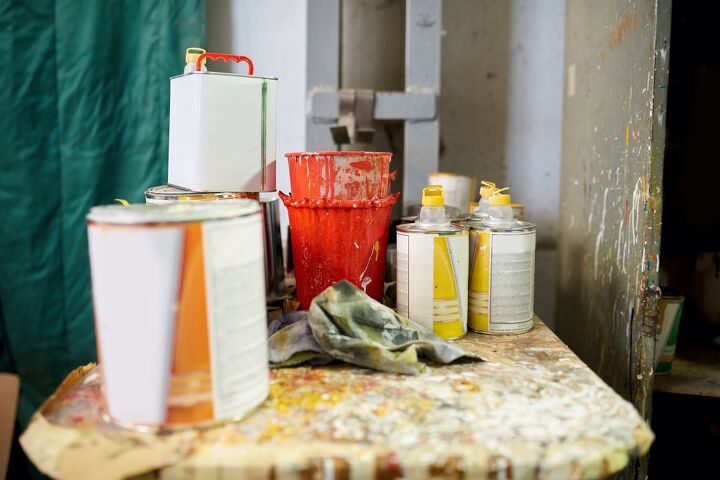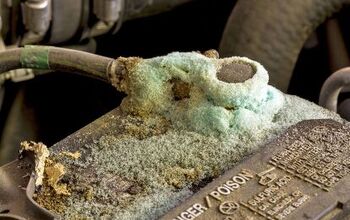How To Dispose Of Paint Thinner (Step-by-Step Guide)

Paint thinner, along with similar solvents, can be very dangerous when disposed of improperly. They can pollute groundwater or potentially cause fires when thrown in your household trash. Not to mention, that the EPA has proposed banning the major chemical found in most paint thinners: methylene chloride. Studies show that short term, it can poison your central nervous system and prolonged exposure can result in lung cancer, liver cancer, and even death.
To prevent any hazards to your health and the health of the planet, paint thinners should be handled and disposed of properly. In fact, most jurisdictions consider them a hazardous substance, requiring residents to dispose of them carefully and safely to safeguard the environment and their own health.
Dissolve the paint thinner with mineral spirits, turpentine, and acetone so that you can safely dispose of it. Allow the paint thinner to soak in the solution, then pour it into a separate glass container. Let the old paint thinner evaporate, and throw your old container away in a trash bag if it is dry.
Although there are punishments, fines, and laws in place to discourage improper disposal of paint thinners, many are not even aware of the correct methods.
Do You Need Waste or Junk Removal Services?
Get free, zero-commitment quotes from pro contractors near you.

What is Paint Thinner?
Generally speaking, paint thinner is a broad term that is used to describe a wide range of solvents that are specially designed to thin paint or clean paint off of brushes, rollers, and other painting tools. Some common examples of paint thinners out there include acetone, turpentine, xylene, toluene, and naphtha.
These are powerful solvents that work to break down oil-based paints, stains, and primers. As a result, they make it easier to remove paint form a surface or painting tools. Though, as the name suggests, paint thinner can also be used to thin paint by reducing the paint’s viscosity. This may be necessary for the purpose of achieving a different finish on a project or when using a paint sprayer.
Since most paint thinners contain powerful chemicals that can be harmful to the user’s health and the health of the planet, they must be disposed of carefully.
How to Dispose of Paint Thinner
Examine the steps outlined below on how to dispose of paint thinner and keep your neighborhood, yourself, and the planet out of harm’s way.
Step One: Disposing of Paint Thinner Soaked Rags
After you’ve completed your project involving paint thinner, you likely have quite a few rags that are saturated in the material. Instead of reusing these rags or placing them in the wash, they need to be disposed of appropriately.
Simply put, rags that have any sort of paint thinner or even oil-based paint residue are highly combustible. They can very easily combust in air and result in a serious fire. To dispose of rags soaked in paint thinner, you should place them in a tightly sealed metal container, such as a clean paint can, and fill it up with water. Then, bring this container to a hazardous waste collection site nearest you.
If you don’t have a watertight container, the alternative solution is to spread out the rags in a ventilated space and on a non-flammable surface. Make sure that they are laid down without any overlapping or bunching. Supervise them until they are completely dry and then seal in any sort of fireproof container you have around the house.
Step Two: Leave Used Paint Thinner to Separate
You do not have to throw out paint thinner after one use. In fact, there are careful steps you can take to recycle and save it for reuse later on. After you’ve soaked your rollers or brushes, pour the used paint thinner into a glass container. Mark the date, and type of paint thinner on the outside and seal it up and away from flame, heat, and spark.
Allow the container to sit for some time and gradually the leftover paint will separate and settle at the bottom. Depending on how soiled the paint thinner is, this process could take anywhere from a couple of days to several months.
Step Three: Salvage the Usable Paint Thinner
After you’ve allowed an ample amount of time for the thinner to sit and the remaining paint to collect on the bottom of the container, you can strain it. Use a layer of coffee filters over a clean glass jar and pour the paint thinner into it. This will extract the usable paint thinner, leaving any residue at the bottom of the old jar or on top of the coffee filters. Make sure you leave a little bit of space at the top of the new jar; then, seal it tightly and label it appropriately.
Quick Tip: You should ALWAYS use either nitrile or heavy rubber gloves when you’re dealing with paint thinner.
Step Four: Disposing of Paint Residue
Once you’ve extracted the usable paint thinner, you need to tackle the leftover paint in the container. You essentially have two methods for doing this:
- If you have less than 1 cup of material leftover, leave the container open and allow it to dry out in a well-ventilated space. You can add in sand, sawdust, or cat litter to help speed up the drying process. For the duration, make sure that this container is kept out of reach of children and pets, and away from anything that could create a fire hazard.
- If you have more than 1 cup of material leftover, or the solvent contains a halogenated chemical (anything with “iod-,” “fluor-,” “chlor-,” or “brom-” in the name) you should take the container immediately to a hazardous waste facility. Although these chemicals are not generally found in paint thinners, they are sometimes found in degreasers and paint strippers.
When your container of less than one cup of material has fully dried and is completely solid, wrap it up in a piece of newspaper and seal it tightly in a plastic bag. This bag can now be safely disposed of in your household trash. Again, anything more than one cup must be brought to a hazardous waste site for proper disposal.
If you’re ever unsure what your standard waste collection service will collect, call them to confirm.
Step Five: Disposing of Empty Paint Thinner Containers
When it comes to the disposal of a container that once housed paint thinner, you can use your regular household trash as long as there is less than one inch of dried residue in the bottom. Do not place these containers in the recycling.
If you have any sort of liquid or a larger amount of dried residue leftover inside the container, take it to a hazardous waste center for collection and disposal.
Disposing of Leftover Paint Thinner
The easiest way for getting rid of leftover or excess paint thinner that you have no use for anymore is to give it away to someone who needs it. Offer it up to a neighbor or friend, or consider donating it to a local organization that can put it to good use on renovation projects.
Your other option in this instance is to take the paint thinner to a hazardous waste collection facility in your area. Many municipalities have specific sites that are permanently in place to drop off hazardous materials such as paint and paint thinner. You can find a local center by doing a quick online search for “hazardous waste collection near me.” Include your city in the search and you will yield a comprehensive list of local disposal centers.
The United States Environmental Protection Agency (EPA) also has an online database of links to waste programs by state for easy navigation. Most hazardous waste facilities accept paint thinner that is placed in a sealed glass or metal container. If you have a large amount of waste to dispose of, contact your local facility directly for guidance.
In addition to having dedicated collection facilities, many jurisdictions host annual or semiannual events for hazardous waste disposal. You can find information about these events through your local government website or check with the Department of Environmental Protection in your state.
Can You Put Paint Thinner Down the Drain?
You should never pour paint thinner, paint sludge, or any type of solvent down your household drain or a street gutter. If for some reason paint thinner does accidentally end up in your drain, you’ll want to minimize the possible damage to your PVC pipes. To do this, fill the sink with very hot water from the tap and pour in a generous amount of dish soap.
Then, stir it up and use tongs to release the stopper and flush the system. Repeat this process a few times to ensure that your pipes don’t get destroyed by the chemicals in the paint thinner. You can also try removing the U-trap underneath your sink to allow the pipes the chance to properly air out. If all else fails, replacing your pipes should only cost you a few dollars.
Storing Paint Thinner
Since paint thinner is highly flammable, it should be stored carefully. When not in use, seal your paint thinner containers and store them in an area that is dry, cool, well-ventilated, and out of reach of pets, children, and possible ignition. Make sure that any container that has paint thinner in it is clearly labeled as “Toxic.”
Refer to the manufacturer’s instructions regarding the ideal storage temperature and consider putting the paint thinner in a garage, shed, or basement when the temperatures inside get too hot during the summer. High temperatures can cause paint thinner to evaporate and you risk having the container explode or catch fire.
The Dangers of Paint Thinner
While paint thinner is a common household item that can be helpful for thinning paint or cleaning dirty paint brushes, it is also a highly toxic substance. Paint thinner is a toxic solvent that contains many chemicals that are harmful to the human body. When not handled or disposed of carefully, paint thinner can be very dangerous.
Inhaling paint thinner fumes can not only make you sick and cause allergic or respiratory problems, but it can also cause damage to your brain and nervous system. Prolonged exposure to paint thinner can increase someone’s chances of getting chronic kidney inflammation, pneumonia, cancer, or result in death.
Not to mention, paint thinner is usually corrosive and can irritate the skin. Many of the elements in paint thinner are also highly flammable, which poses a hazard to your home as well. So, when using paint thinner you should always wear the necessary protective gear such as gloves, eyewear, and a face mask. Ventilation is essential, and you should only use paint thinner in areas that have plenty of airflow.
To further protect yourself and your home, only buy paint thinner in small quantities and look for natural diluters that contain less harmful ingredients.
Related Questions
How do you safely dispose of lacquer thinner?
You can use the same methods outlined above to throw out lacquer-type thinner. However, it is generally more caustic than standard paint thinner so pay close attention to the manufacturer’s safety instructions and strictly avoid skin contact.
How do you avoid potential static ignition around paint thinner?
In order to avoid the possibility of paint thinner catching fire, never pour or store it in an area that has dust, concentrated fumes, or any other flammable particles in the air. When working with large amounts of solvents (five gallons or more), before you transfer them between metal containers you can connect them together using a bonding strap and a wire. Then, ground the containers to either a pipe or another grounded metal object.
What can you use in place of paint thinner?
If you want to avoid the hazards associated with standard paint thinner, you can create your own homemade version. To thin oil paint, mix together ¼ cup of lemon oil and a cup of linseed oil. For latex or acrylic paints, simply thinning with water will suffice.
Do You Need Waste or Junk Removal Services?
Get free, zero-commitment quotes from pro contractors near you.

Wrapping It Up
Using and disposing of paint thinner should never be taken lightly. If you ever intend on handling this toxic substance, you should be aware of the proper way to dispose of it. Never, under any circumstances, should paint thinner be thrown out directly in the trash or down your drains. If you let dirty, used paint thinner sit, the sludge will settle on the bottom of the jar and allow you to rescue and recycle the usable clear solvent on top. You can then strain the liquid and store it in a clean, fire-safe jar for future use.
If you have a large amount of paint thinner that you need to get rid of, you can donate it to a friend or local organization or take it to a hazardous waste facility near you. When in doubt, disposing of paint thinner at a local hazardous waste collection site is always your best bet.

Jessica considers herself a home improvement and design enthusiast. She grew up surrounded by constant home improvement projects and owes most of what she knows to helping her dad renovate her childhood home. Being a Los Angeles resident, Jessica spends a lot of her time looking for her next DIY project and sharing her love for home design.
More by Jessica Stone



























